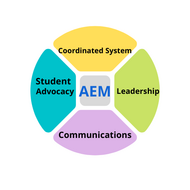AEM Basics
(View Complete Item Description)AIM or AEM? Accessible Educational Materials (AEM) are materials designed or converted in a way that makes them usable across the widest range of student variability regardless of format. In relation to the Individuals with Disabilities Education Act (IDEA), the term AIM refers to print instructional materials that have been transformed into four specialized formats (audio, braille, digital, and large print text). Sometimes students with disabilities have difficulty accessing print in the same way as their peers. To succeed in school, these students need learning materials presented in a way that works for them. In 2014, the term "accessible educational materials" or "AEM" was expanded to include both print- and technology-based educational materials including electronic textbooks, and related core materials. Practically speaking the terms AIM and AEM are often used interchangeably. In the following video learn from AEM users, educators, parents, and state and national leaders about how AEM can be a game changer for those with print disabilities.
Material Type: Primary Source



















